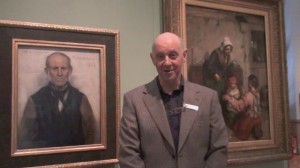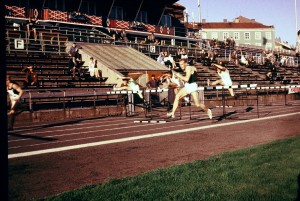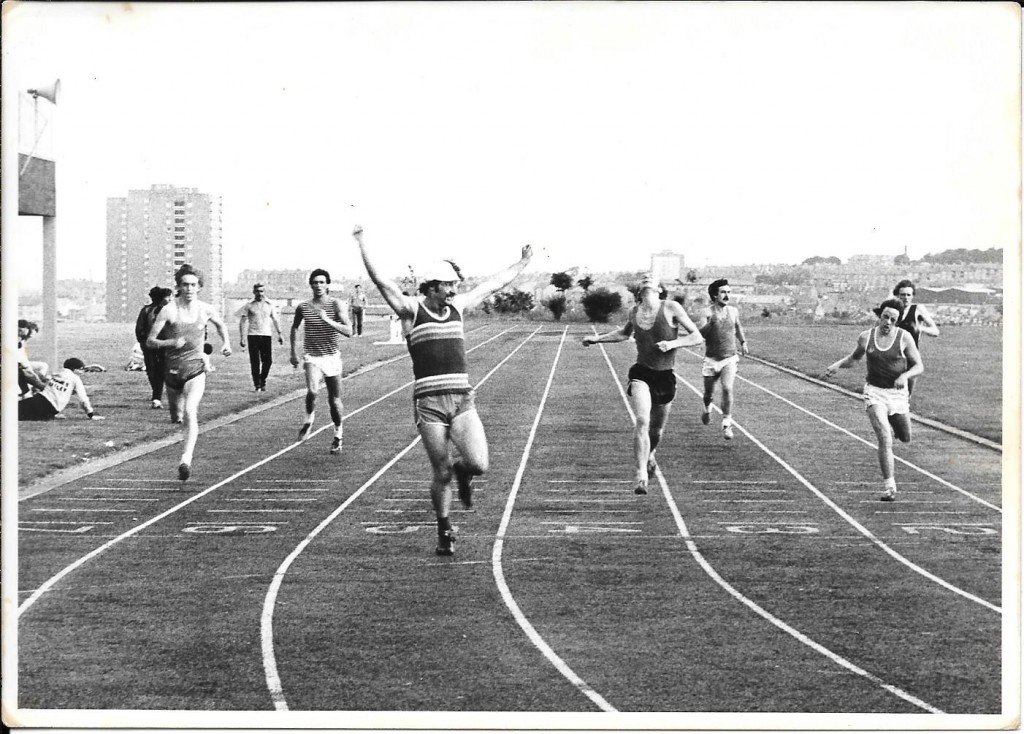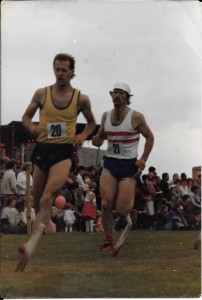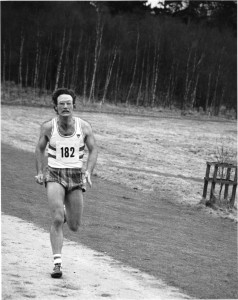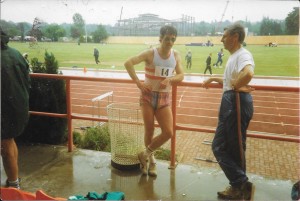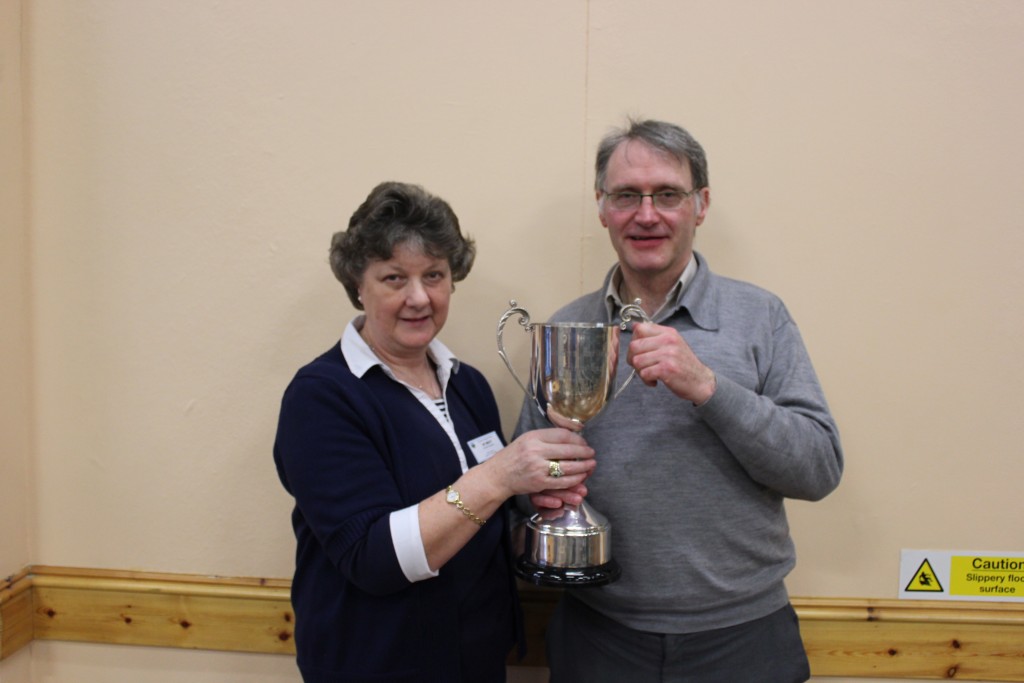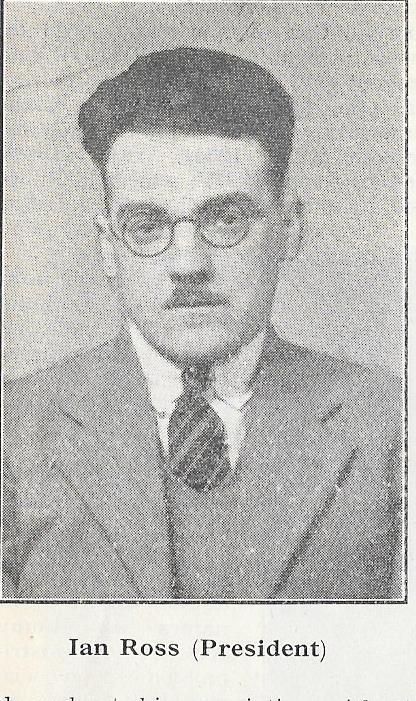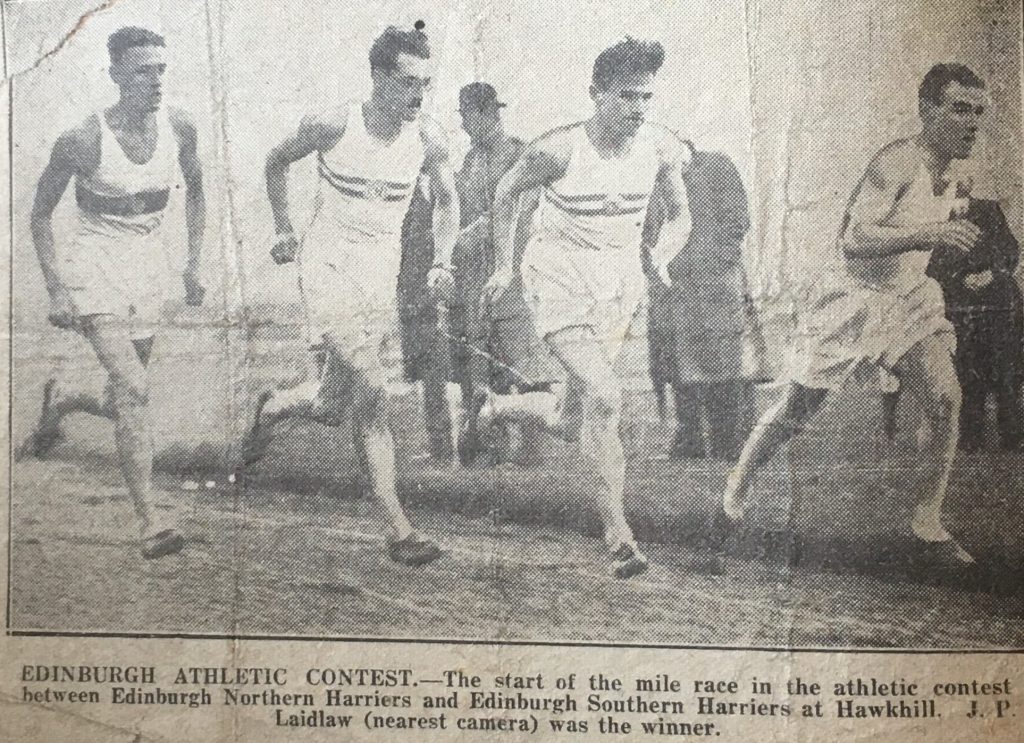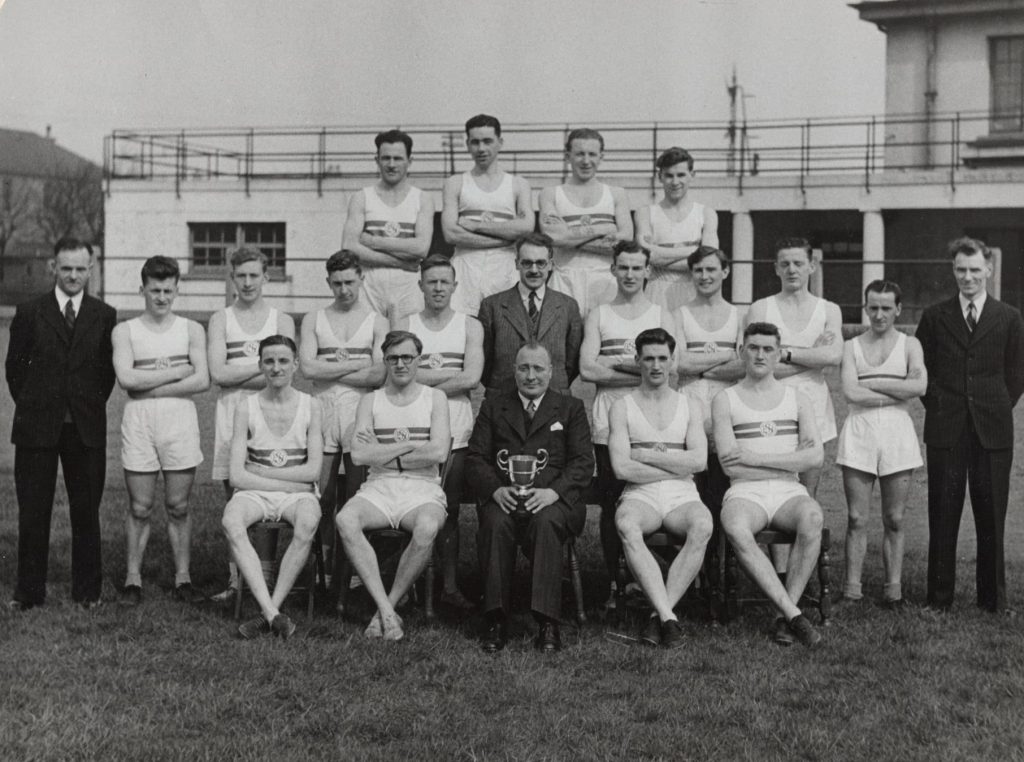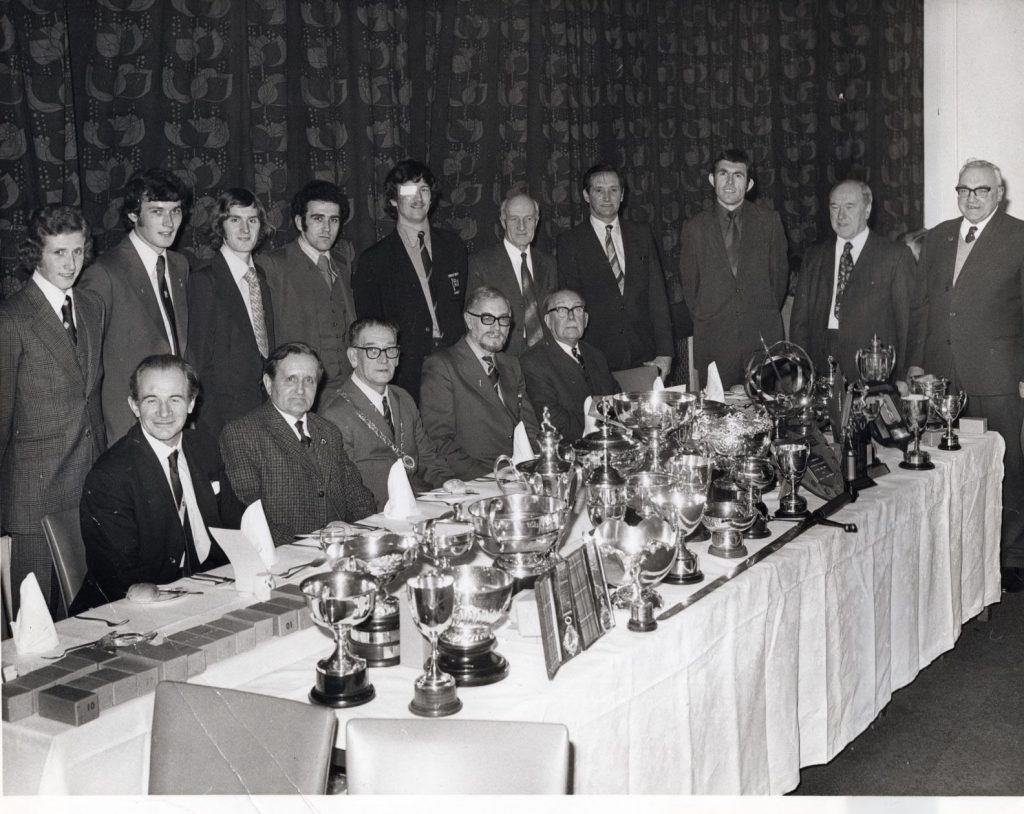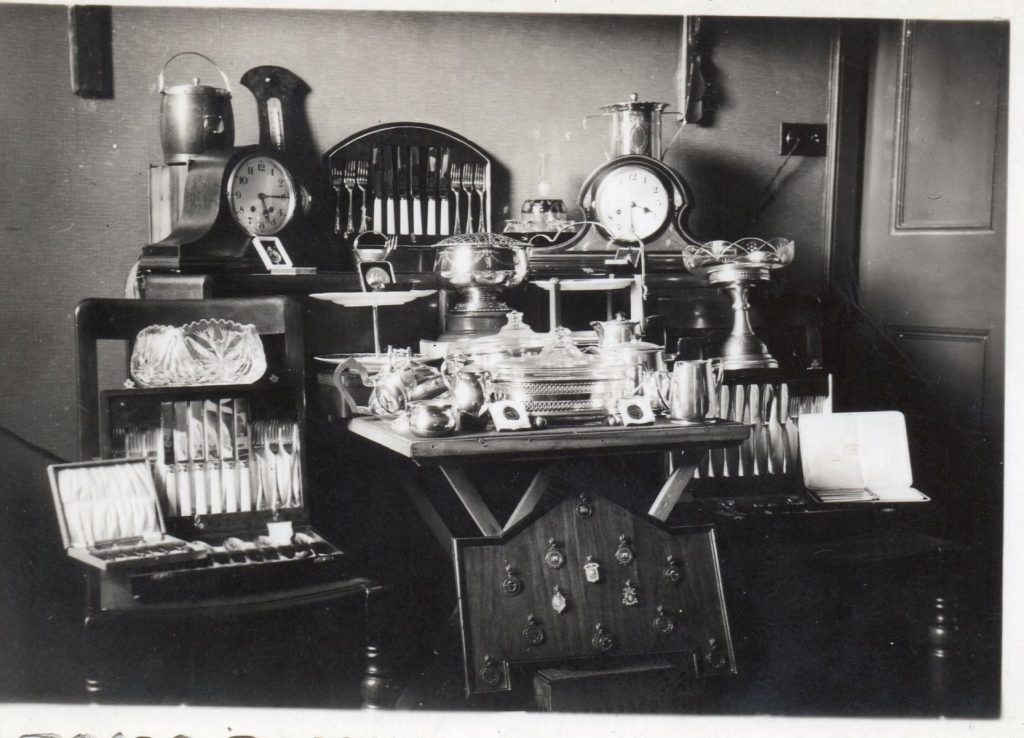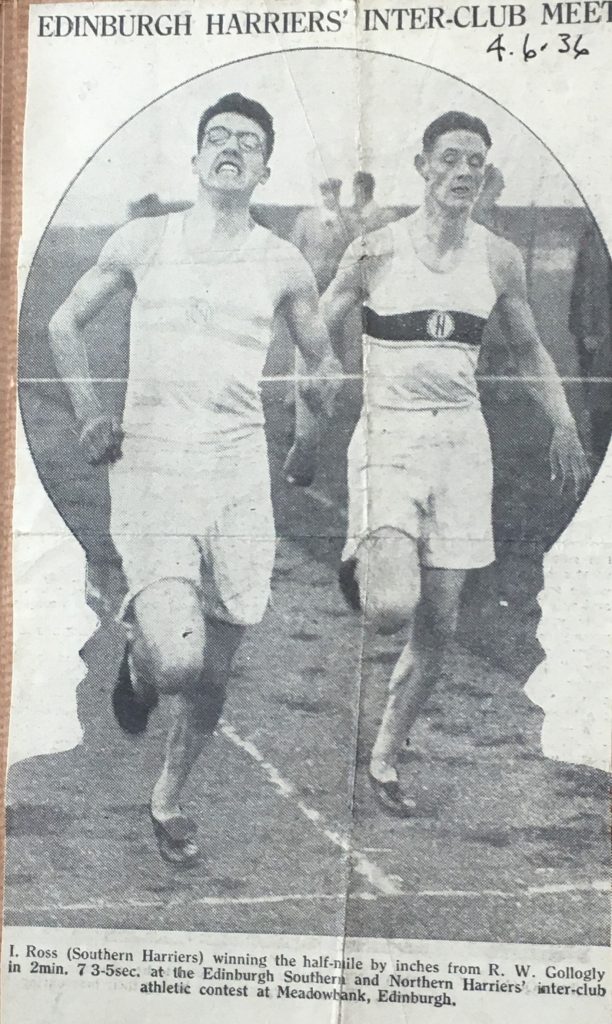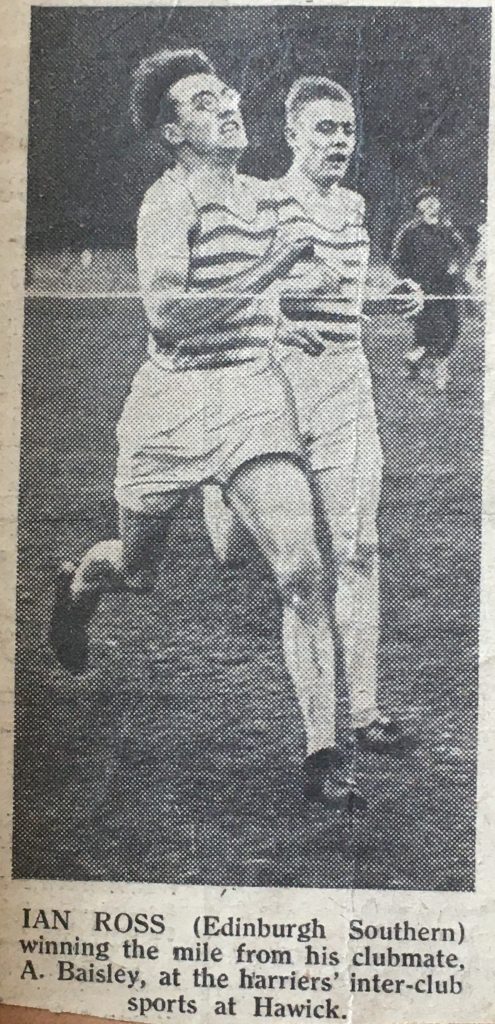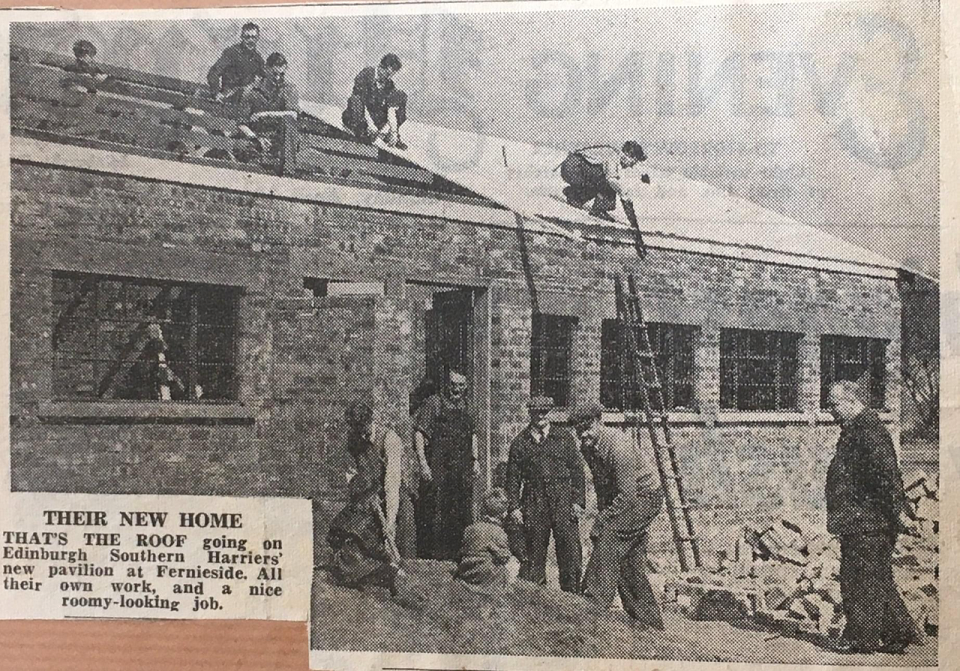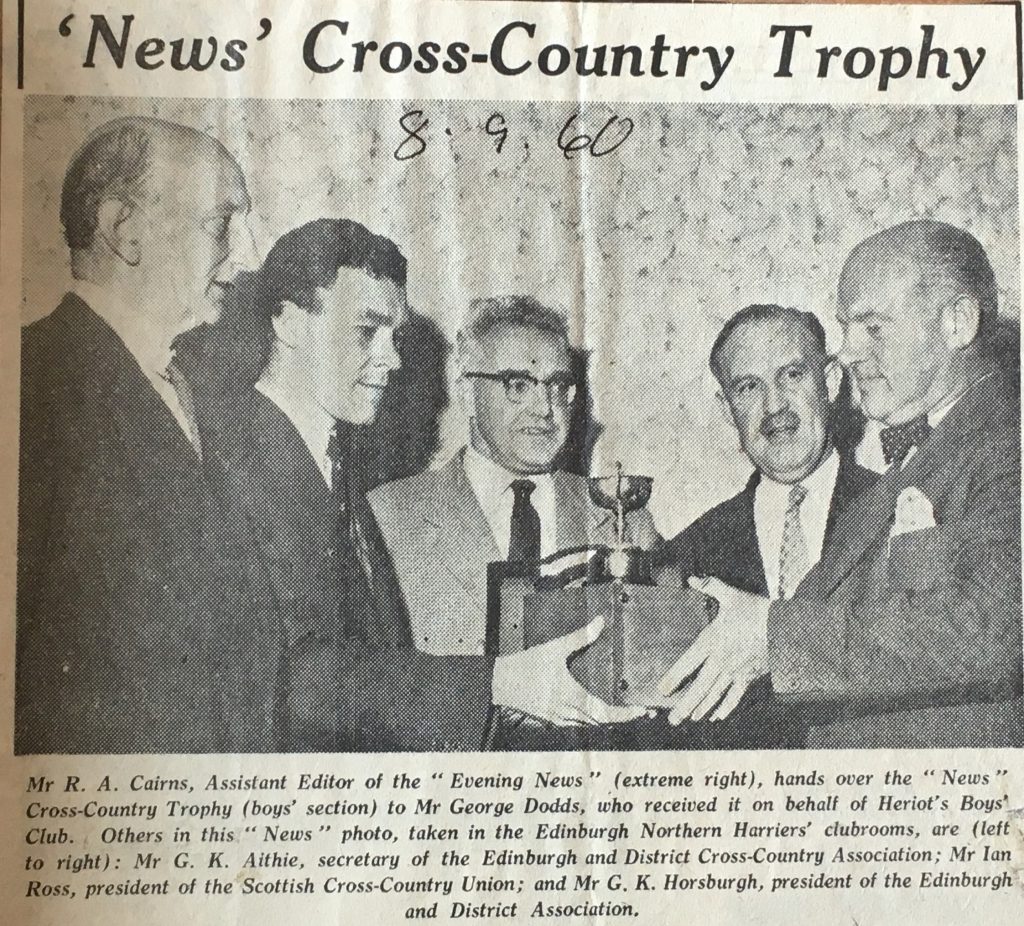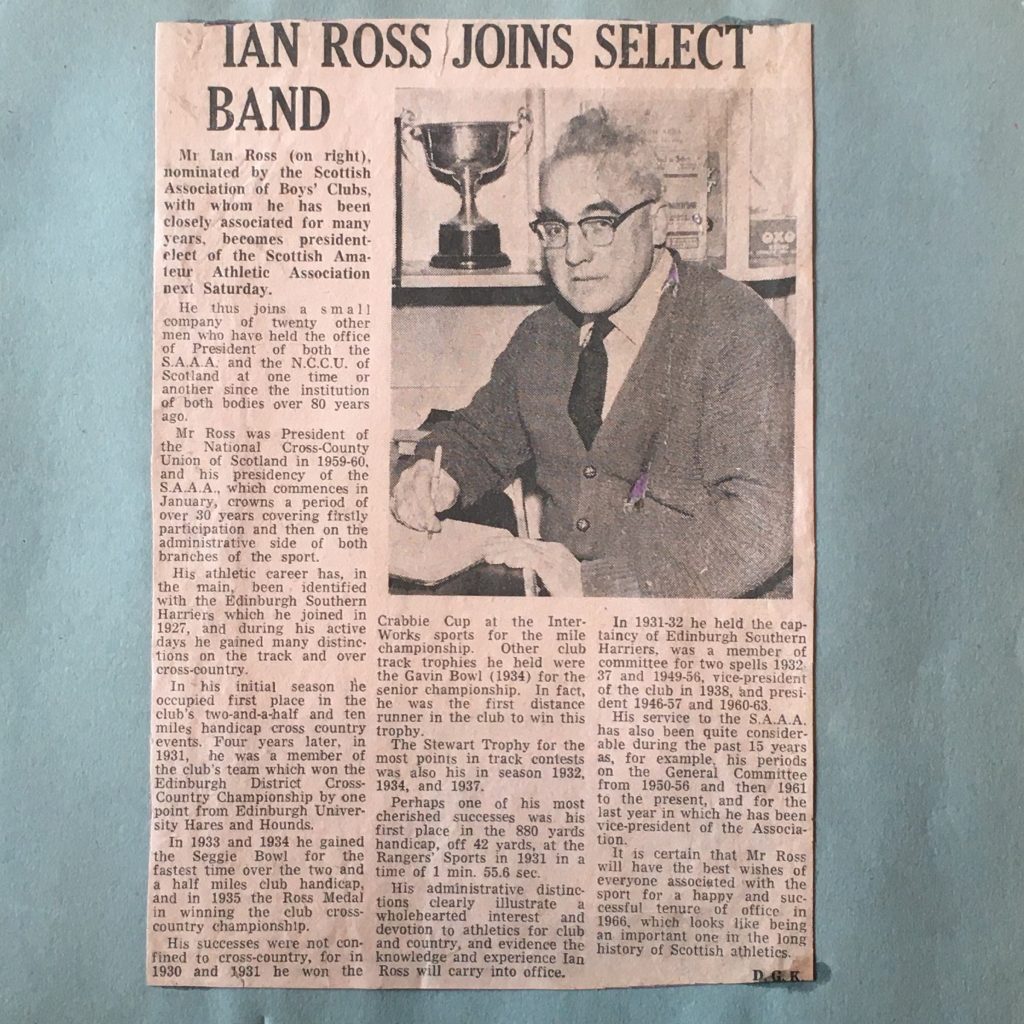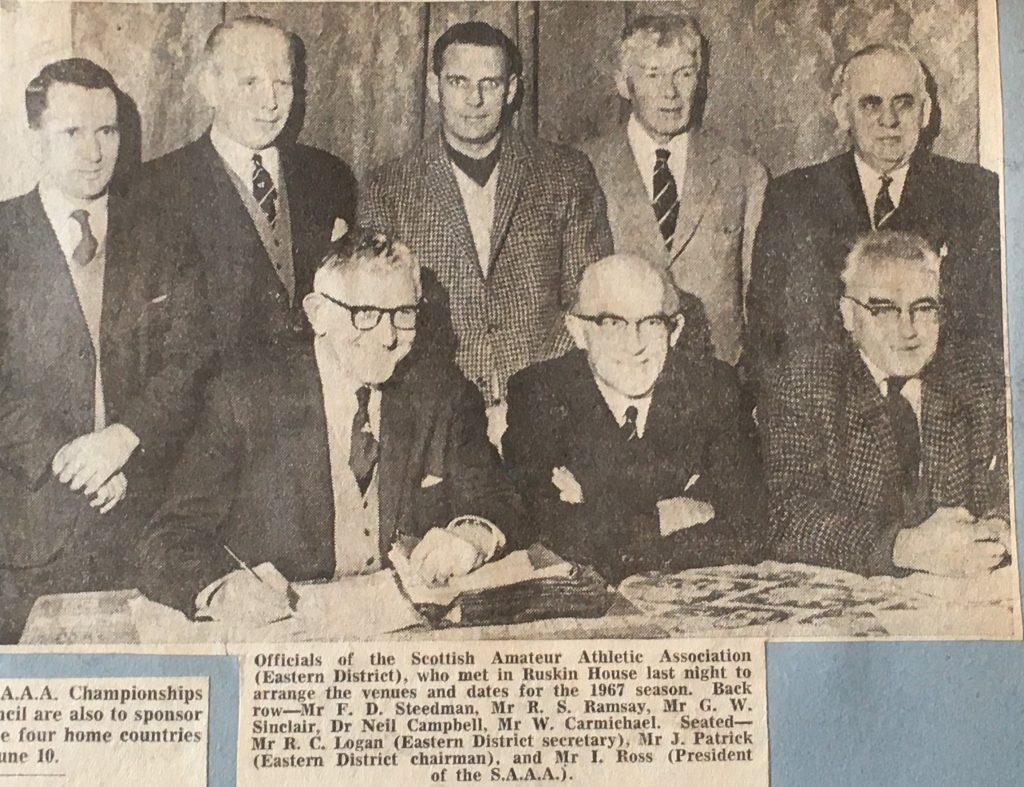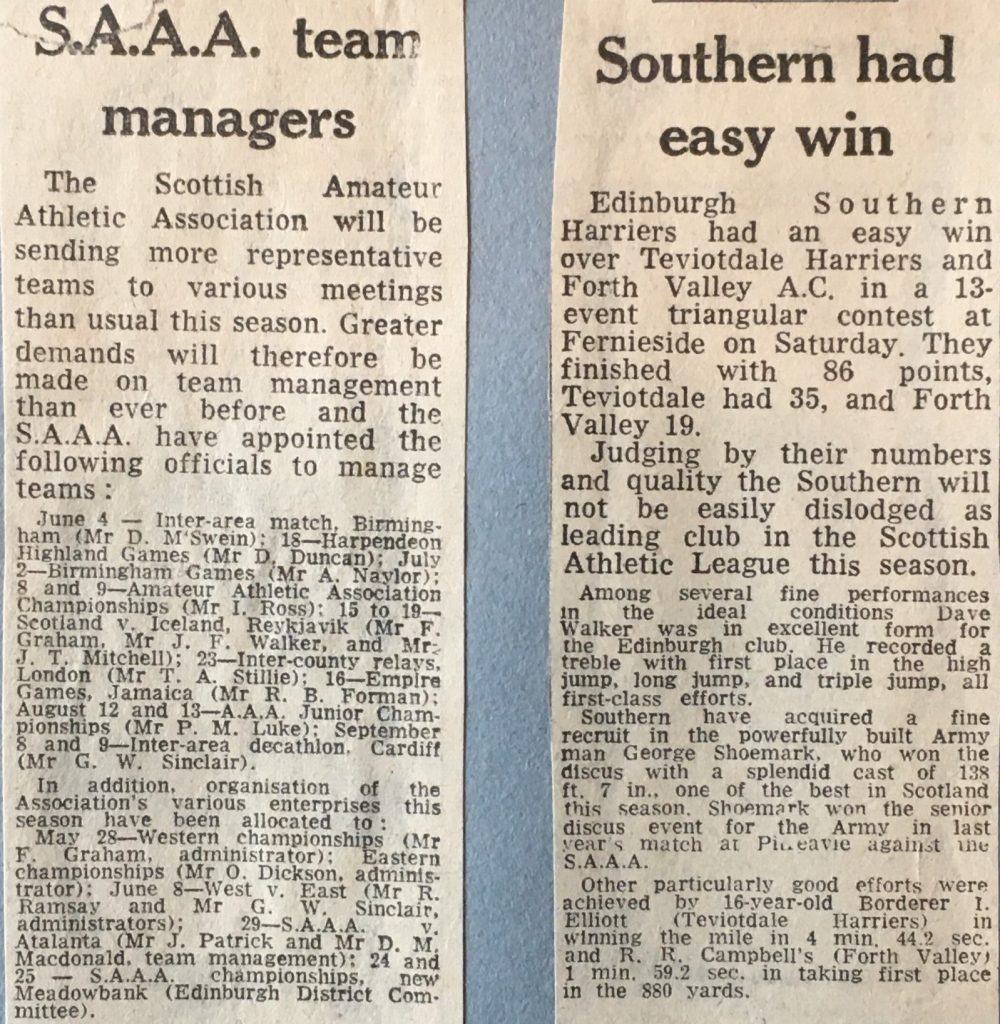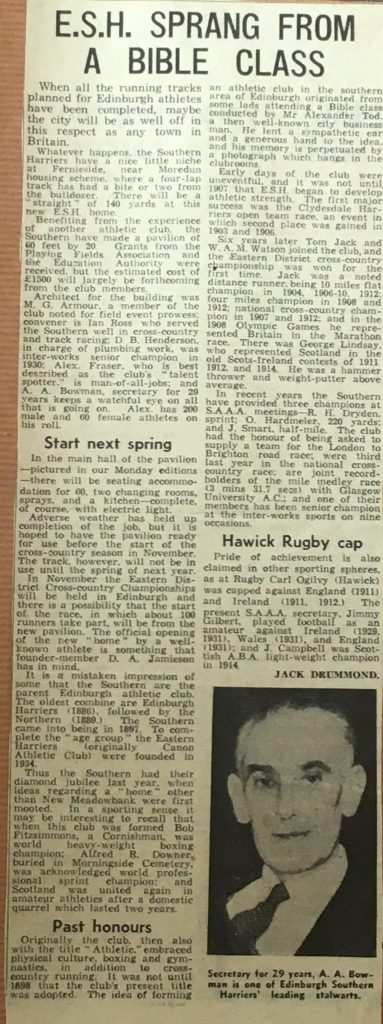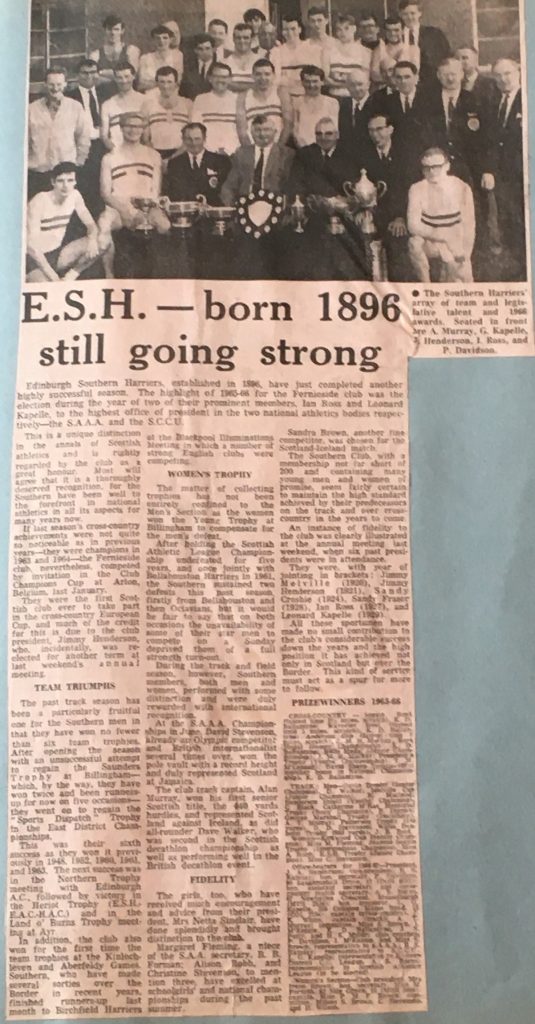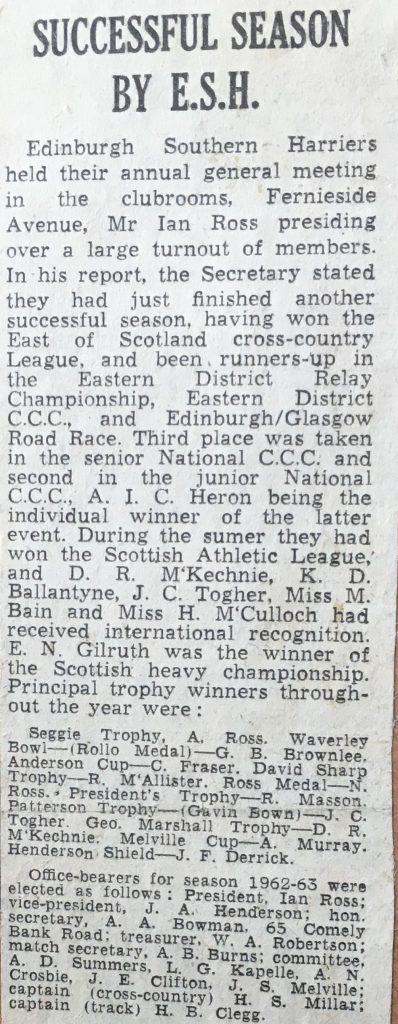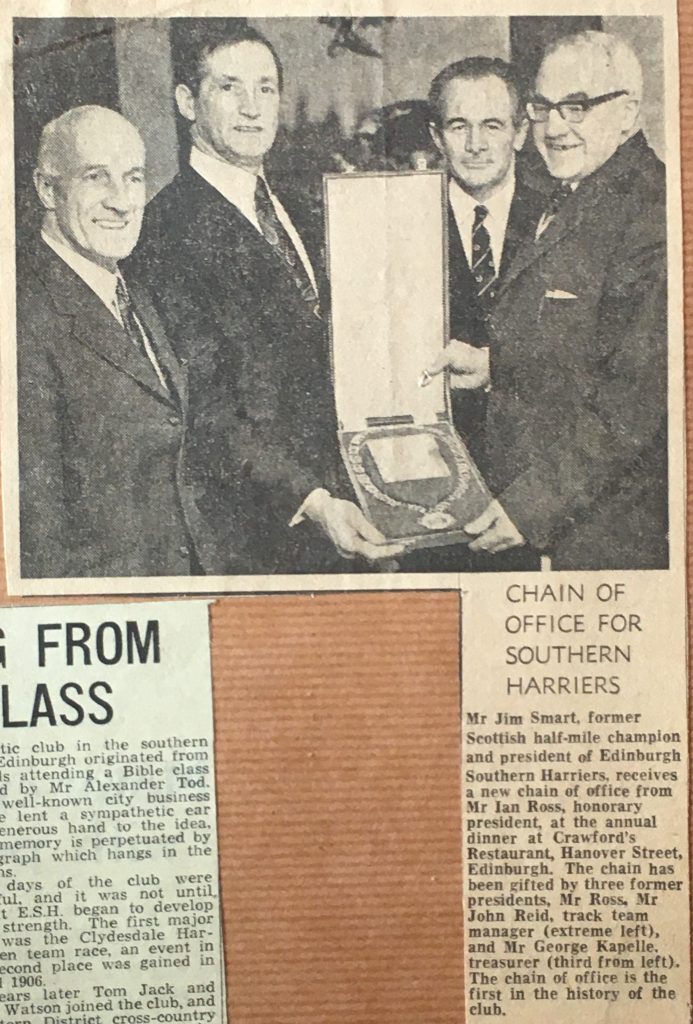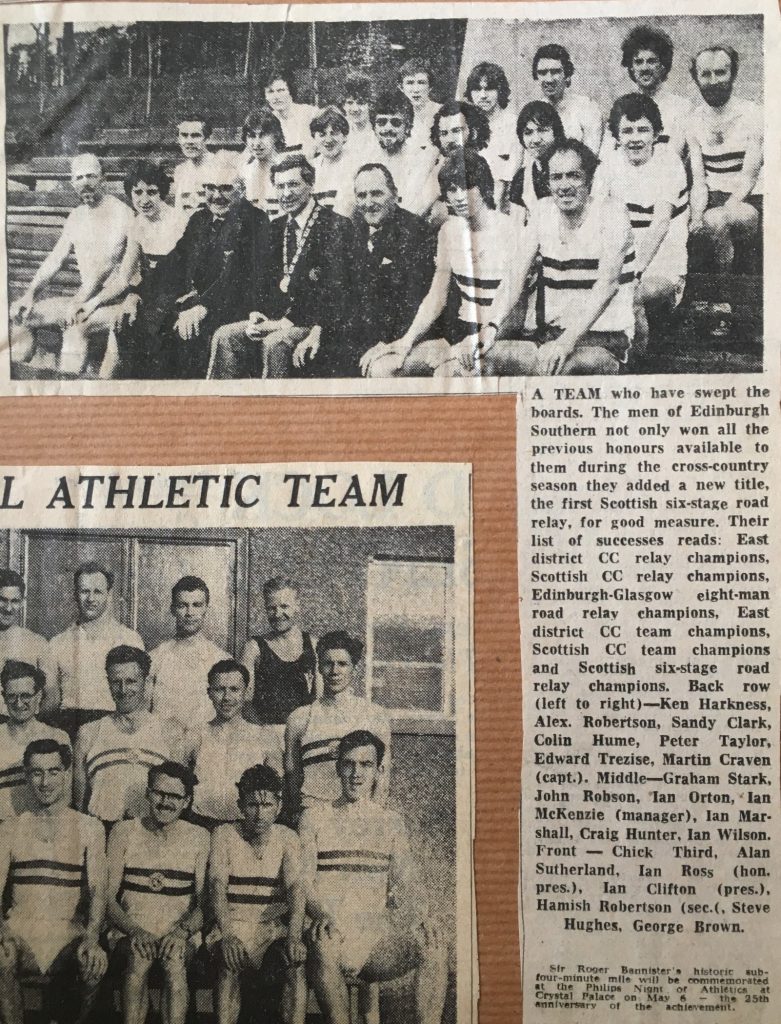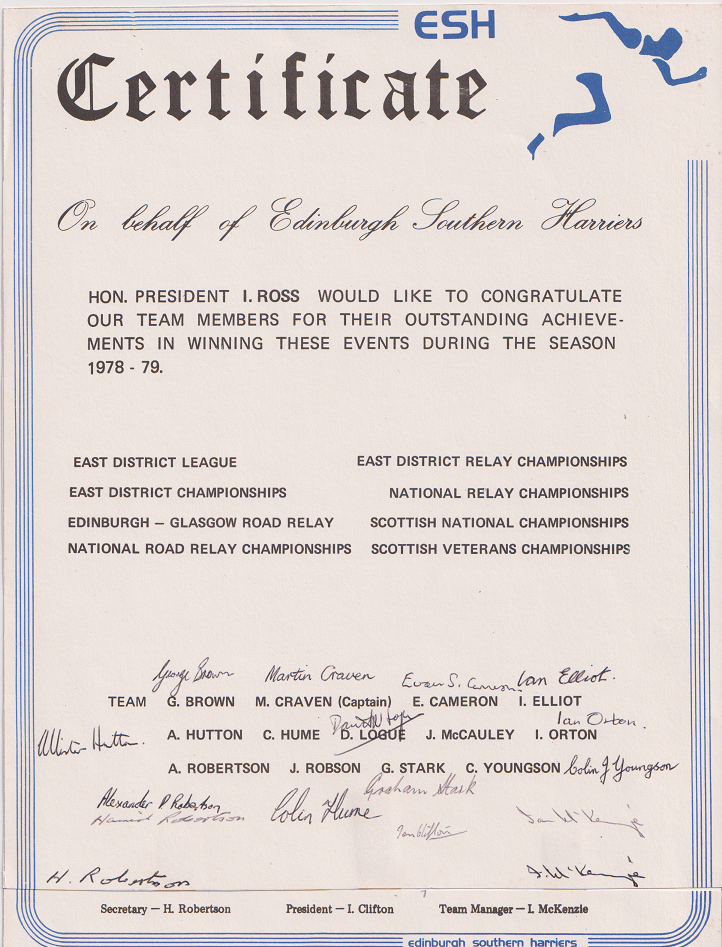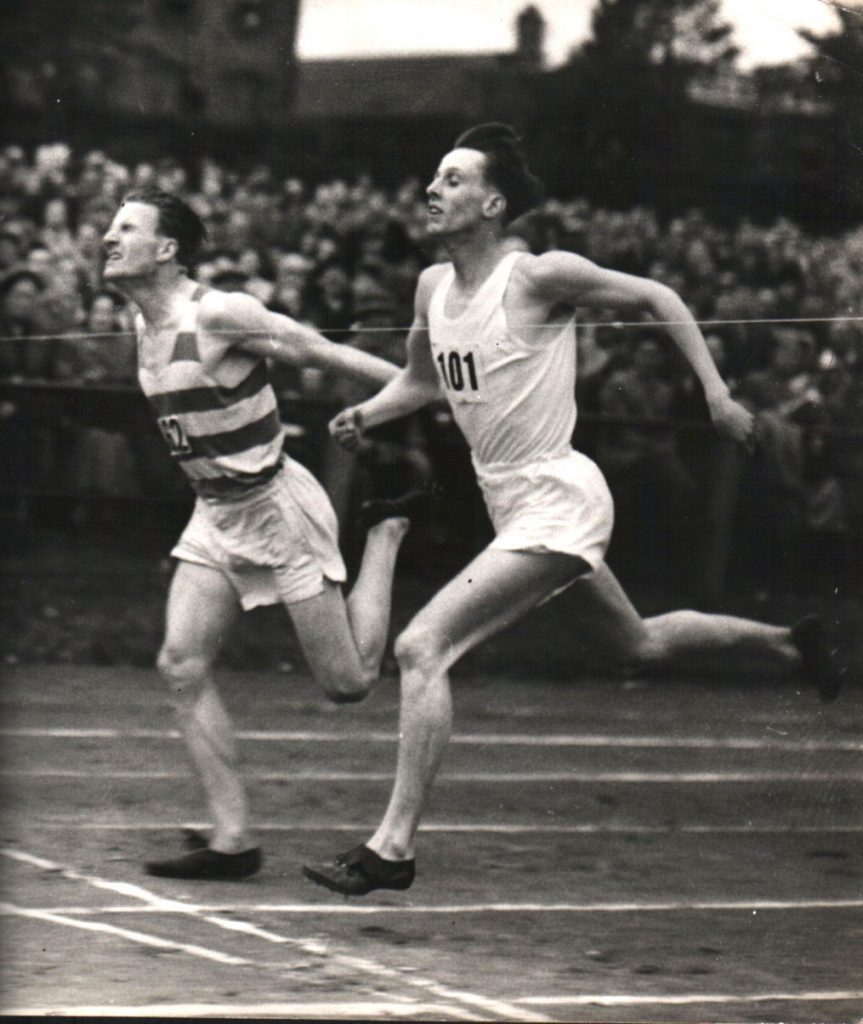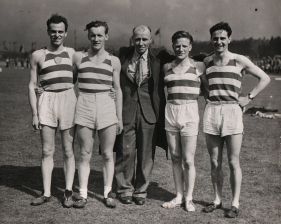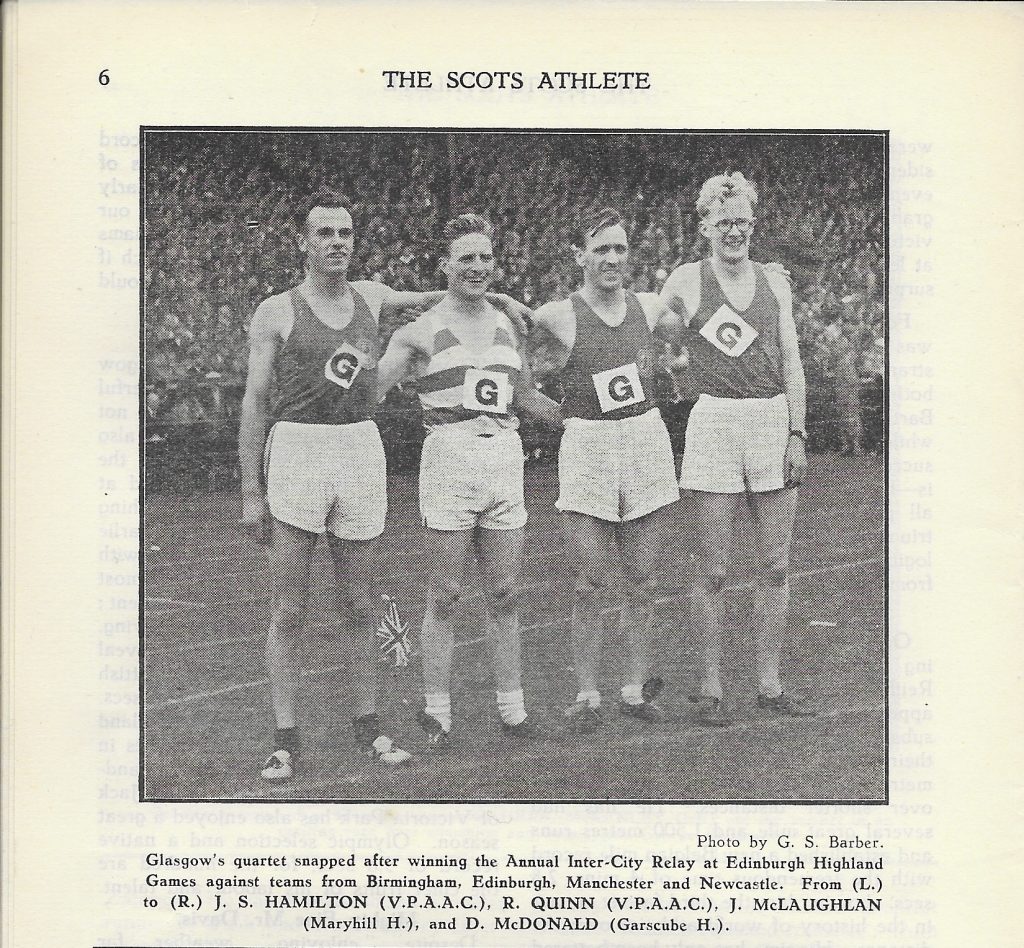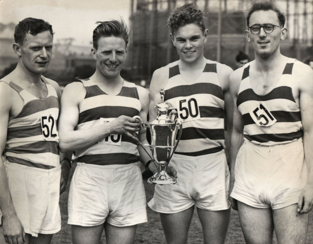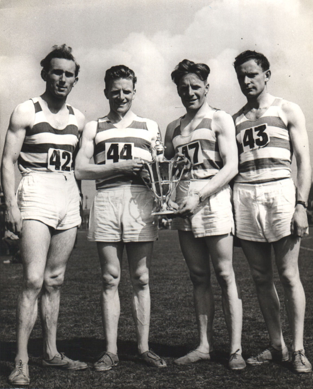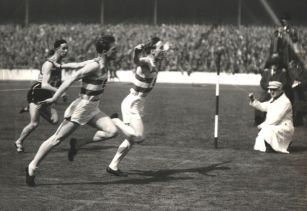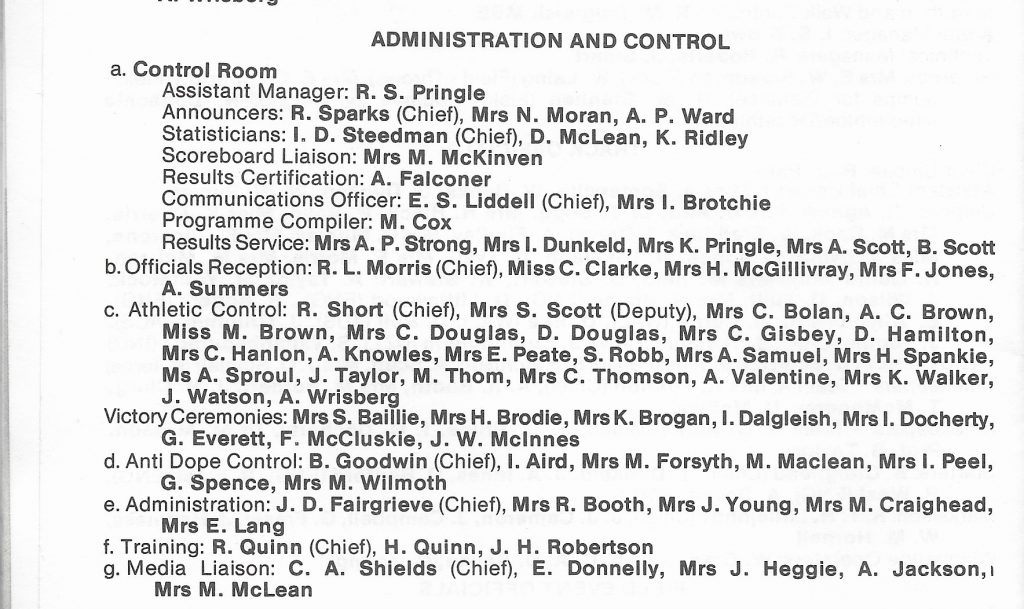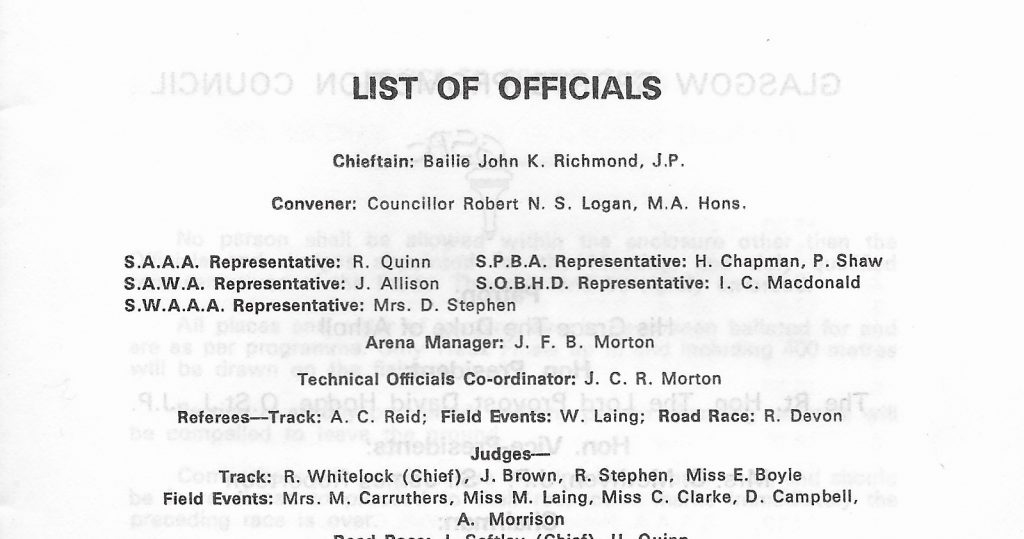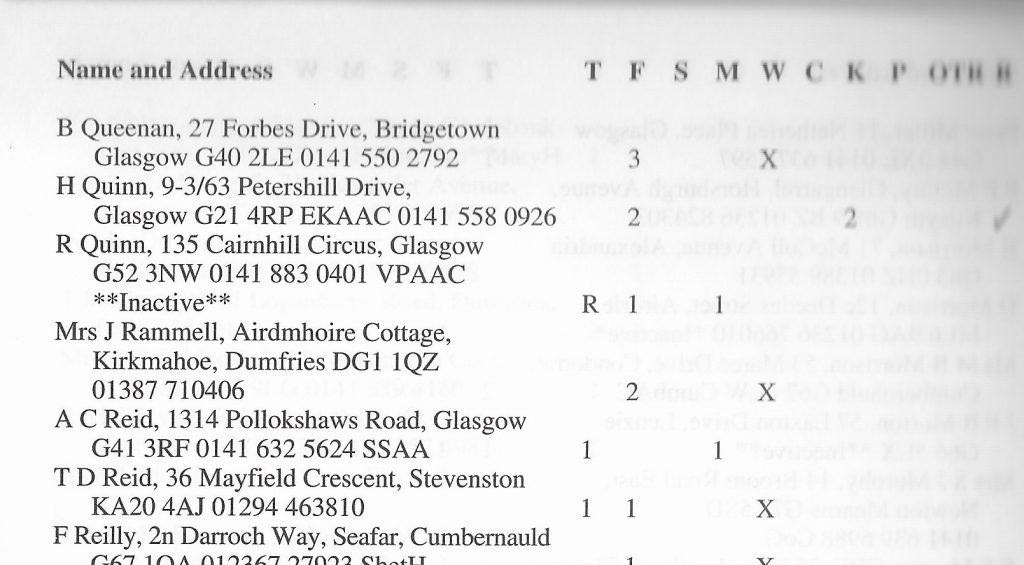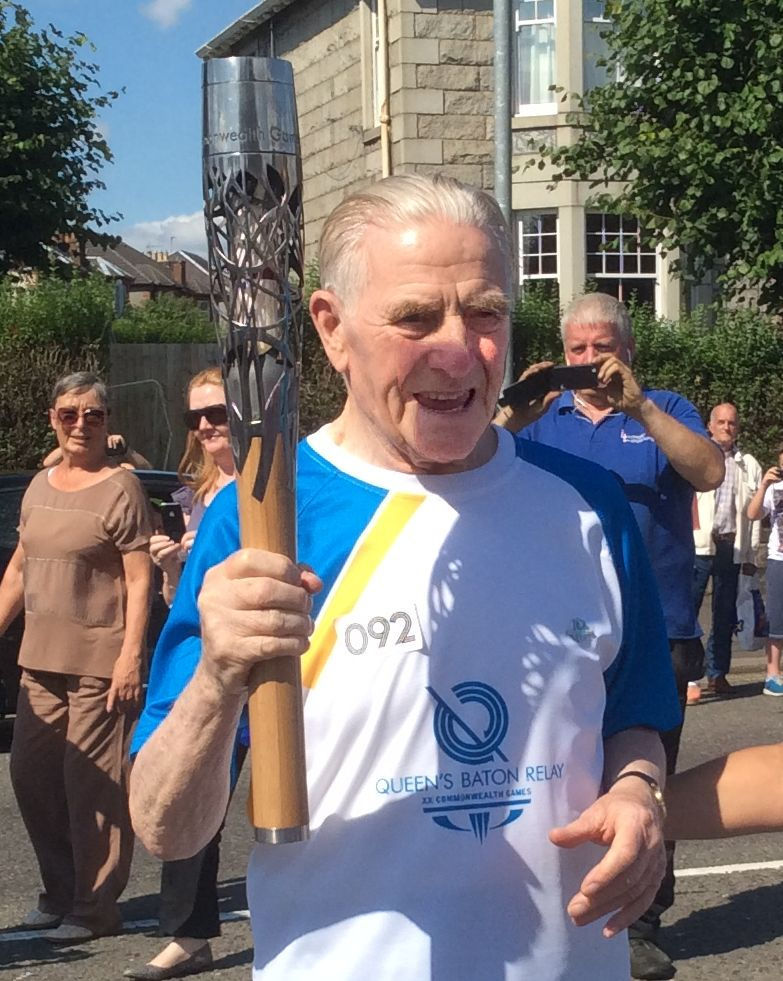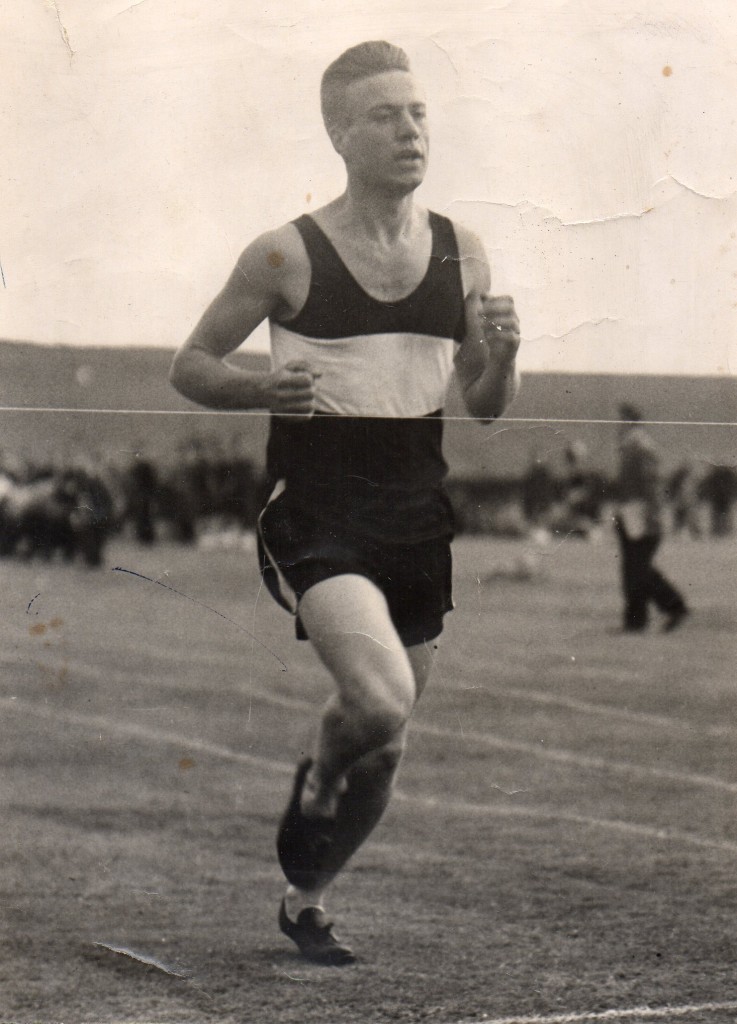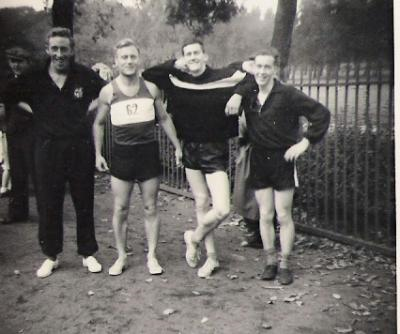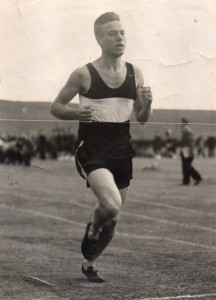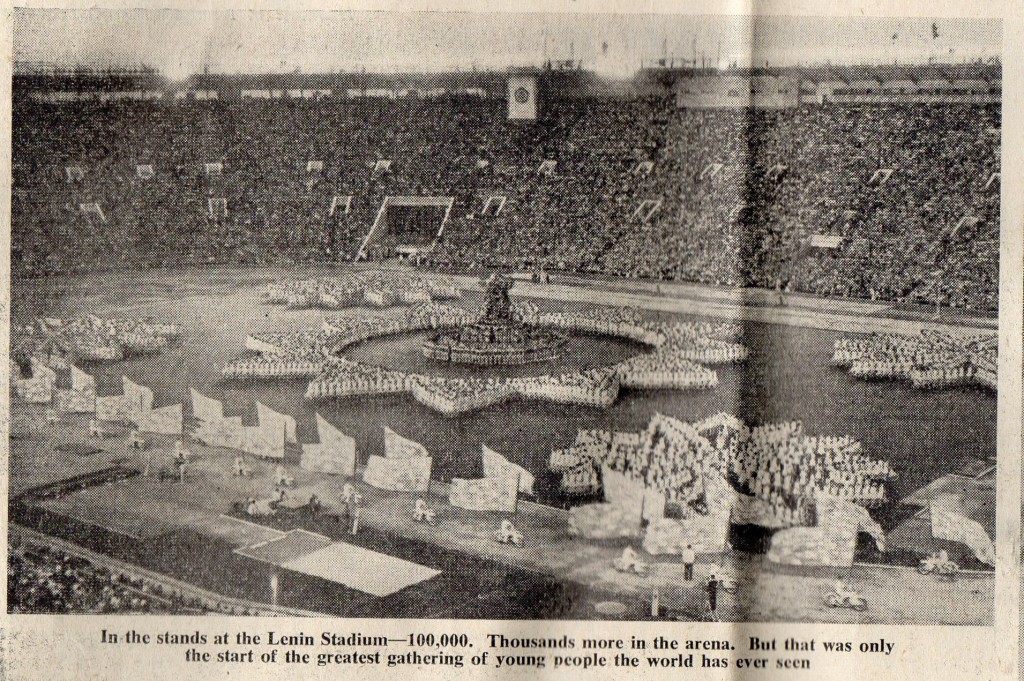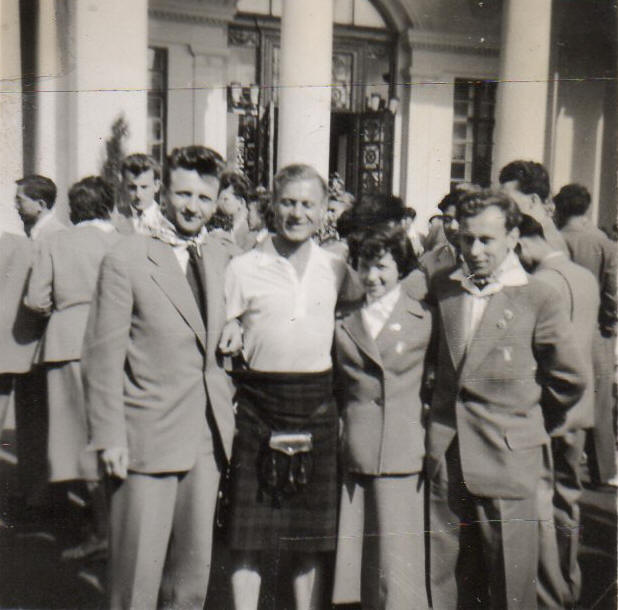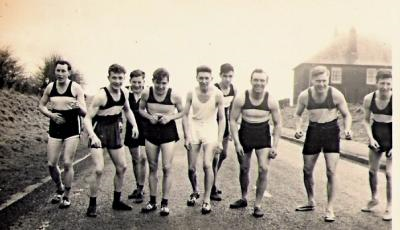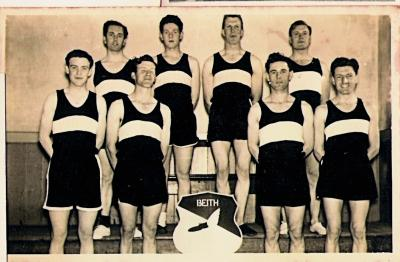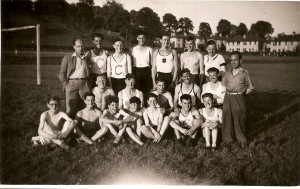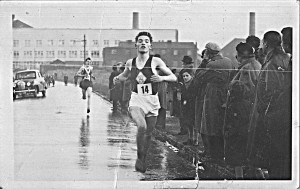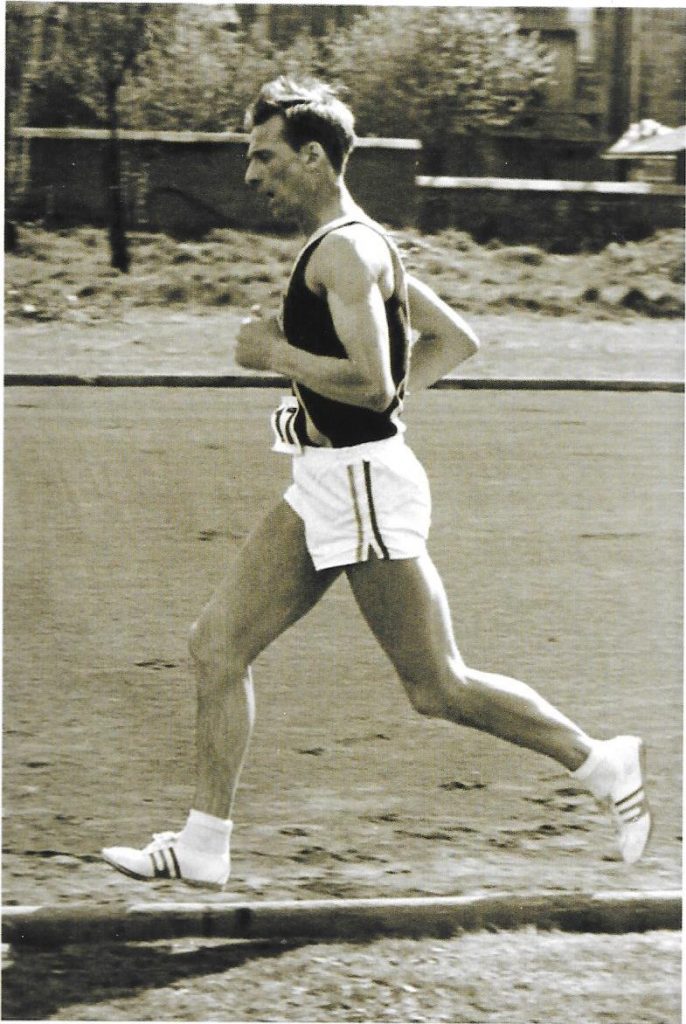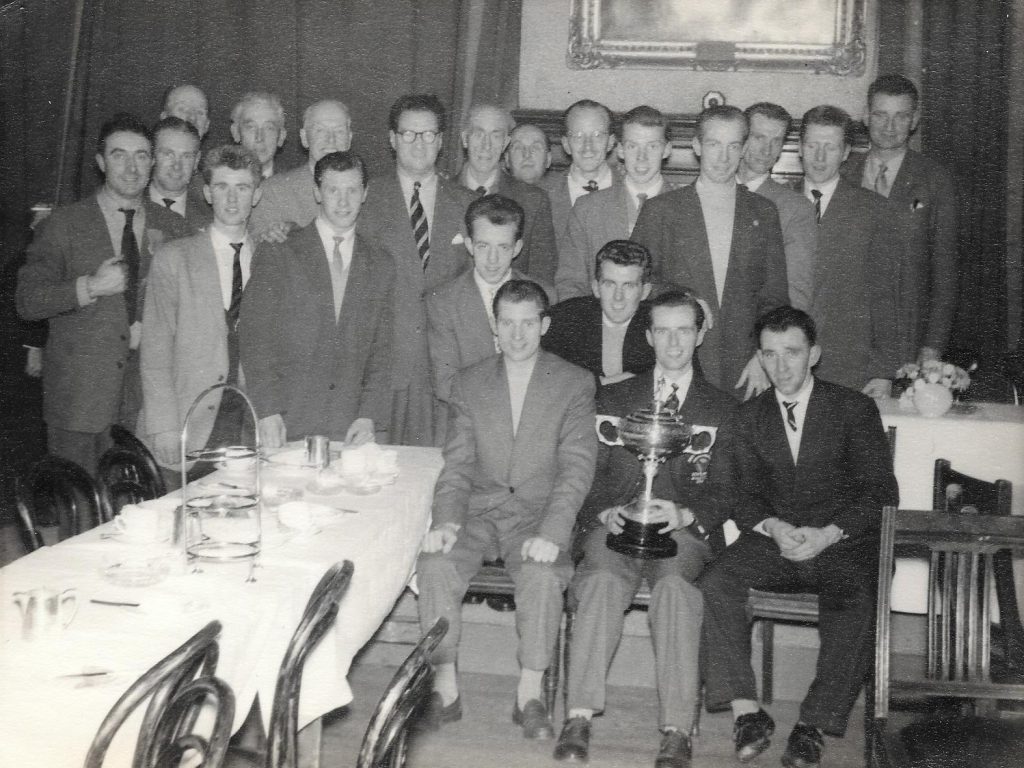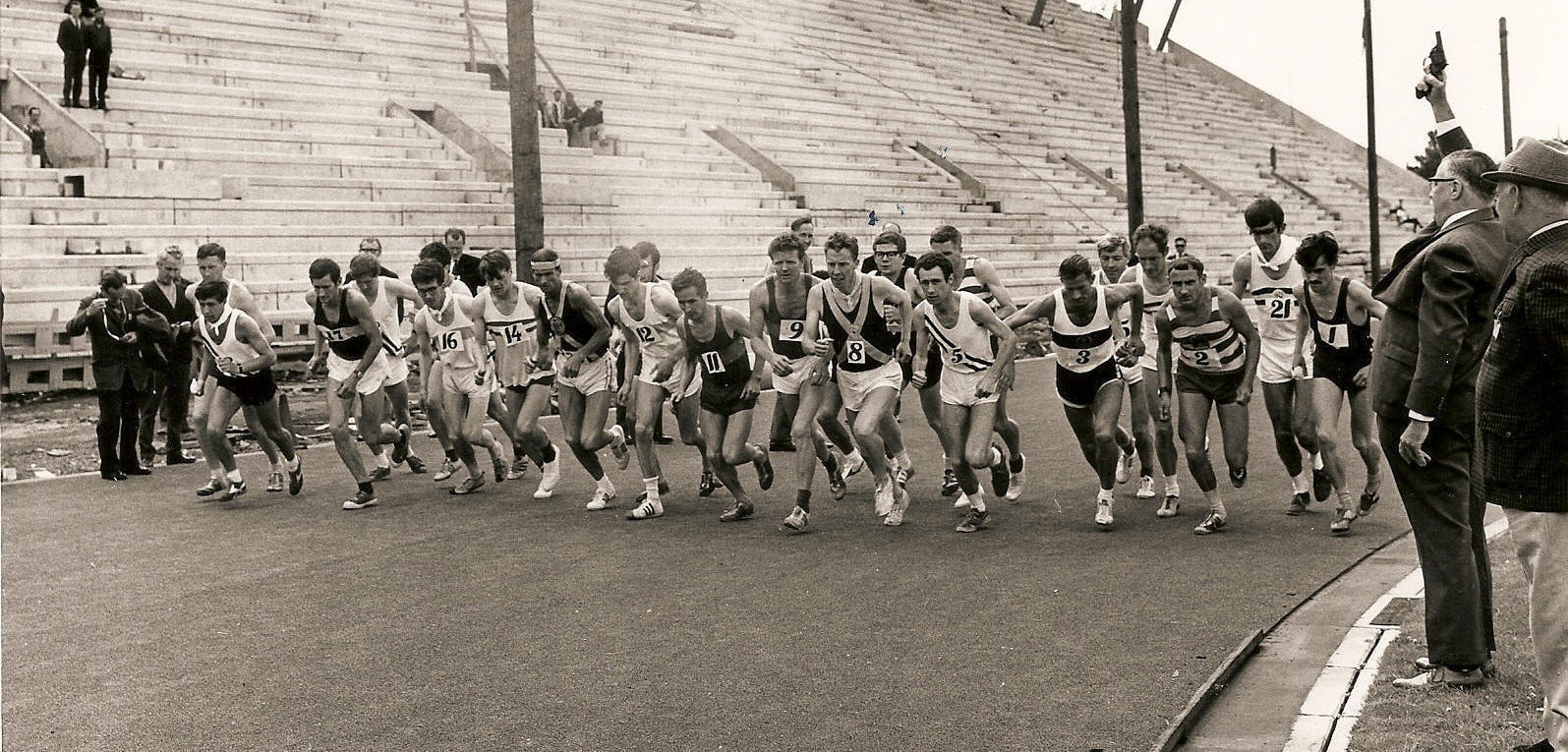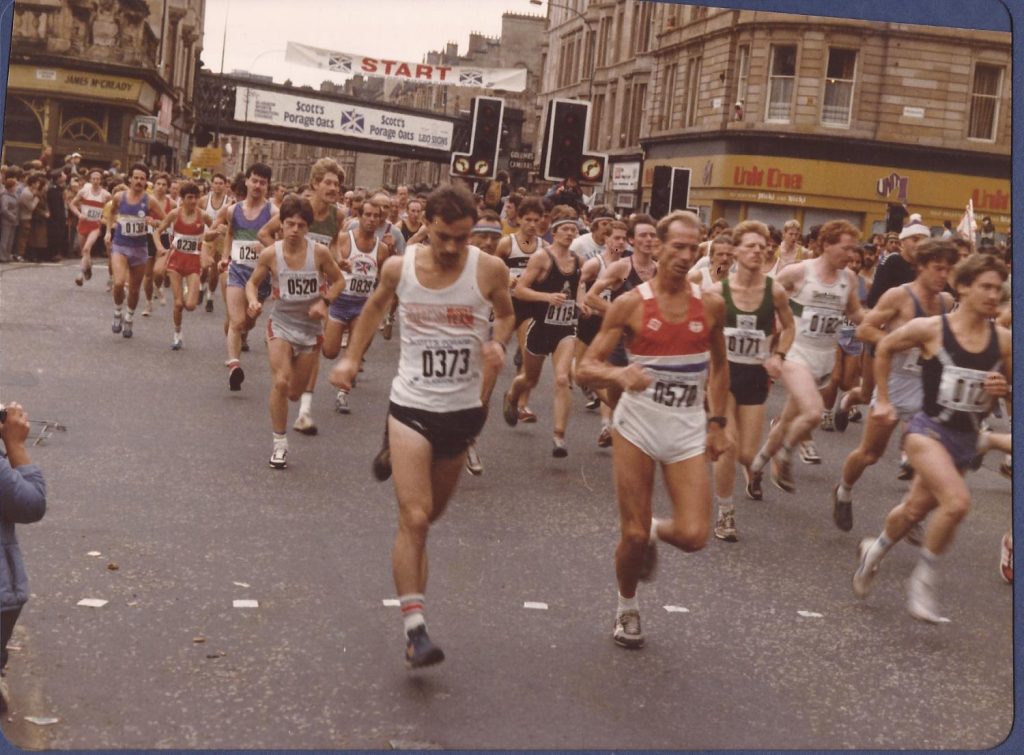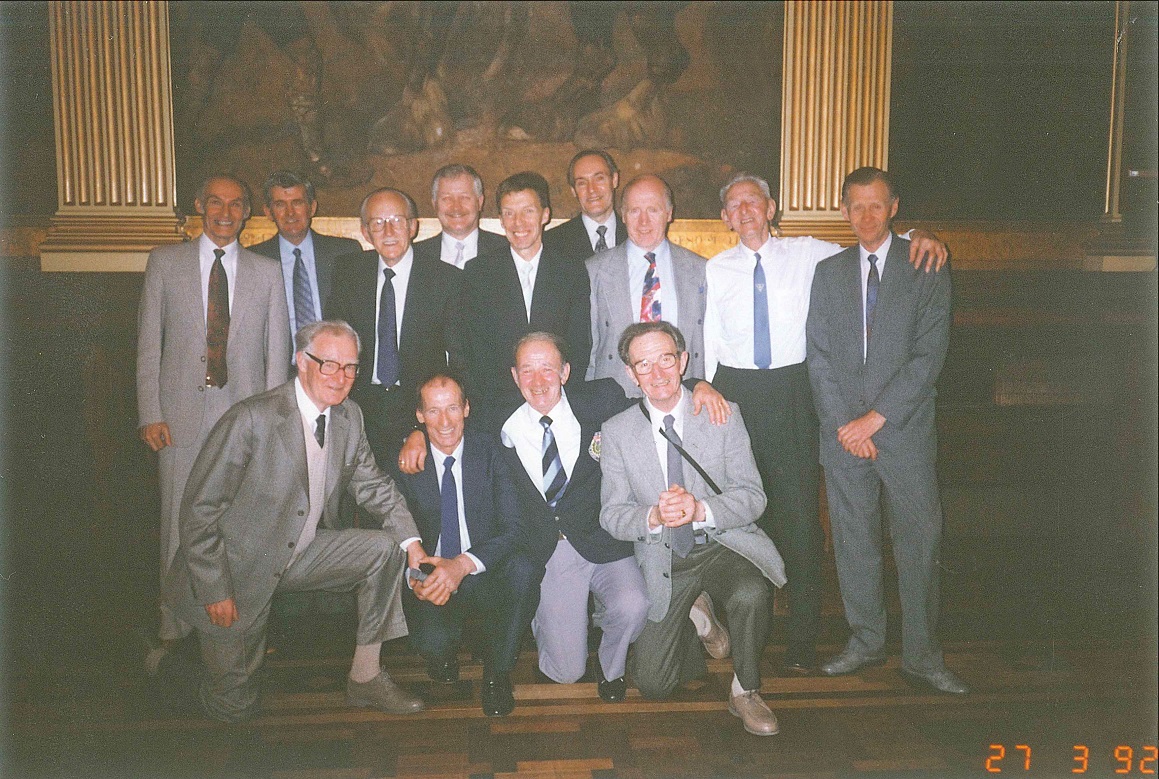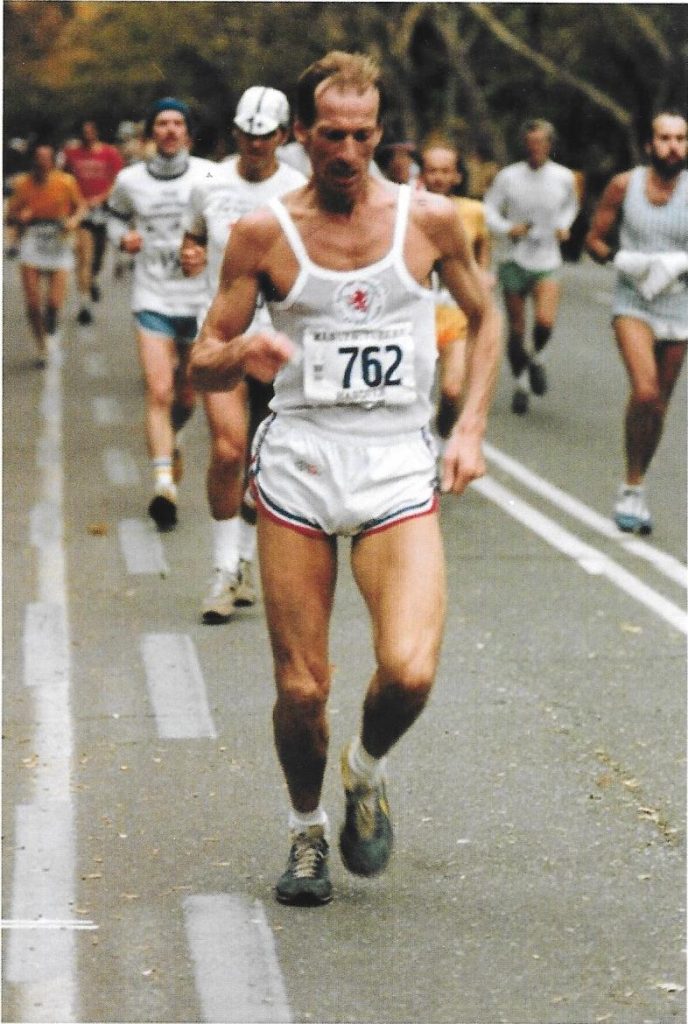Click to go to Kenny Phillips: the runner
This interesting section is not really only about Kenny himself: it concerns the running of athletics in a locality, any locality although this one is in Beith. It illustrates the difficulties that beset any voluntary organisation and all the problems that arise from raising the funds to the occasional unsympathetic official and relations with the governing body.
Kenny returned from Lancashire to Stewarton in 1962 and replaced Harry Maxwell as Secretary of Beith Harriers with Mattha Barr and Hugh Walker as Chairman and Treasurer. The Ladies Section was at a standstill as they had lost the use of the Backburn School but they were thanked for helping with the teas at the New Year’s Day Race and for organising the Bus Run. Members subscriptions were raised from 15/- to £1 for Seniors and from 1/6d to 2/6d for Boys. The District Council was to be asked to organise a Sports Meeting. Harry Maxwell and Kenny were appointed as Representatives to the Ayrshire Harrier Clubs’ Association. The Committee was authorised to spend up to £100 to make the Clubhouse watertight. During his annual report for 1962-63, Kenny congratulated the cross country runners, despite the difficulty in getting sufficient numbers, of being second in the Ayrshire and SW Relays and first in the Ayrshire and SW 6 miles. During the track season, Beith members won prizes at almost every sports meeting but he complained that no team events were entered, training was done individually instead of in groups, the Clubhouse was neglected and the Ladies Section did not meet. The only summer club activity was the Bus Run to Balmaha. Outstanding individuals were:
Ian Harris, who won the Scottish Marathon and was in the Army Cross Country Team which won the Inter-services Cross Country Championships.
Danny McFadyean, who won the Navy, then the Inter-services Cross Country Championship and, the following day, was 12th in the Scottish Cross Country Championship.
Tom Cochrane, who won the Ayrshire 6 miles, SW 6 miles, Club Championship, 9th in the Scottish Cross Country Championship, represented Scotland at San Sebastian, won the Ayrshire 3,000m and 3 miles Championships.
Tom Findlay, who was first in the Boys Ayrshire and second in the SW races.
Jim Millar, who won the Ayrshire 1 mile and was 3rd in the Ayrshire 1/2 mile.
Dave Shedden, who was 2nd in the Ayrshire 100 yards and long jump and in the Scottish Junior Championships was 2nd in the long jump, 3rd in the 100 yards and 220 yards.
*
In 1966, Kenny, along with Harry Maxwell, when representing Beith Harriers at the Ayrshire Harrier Clubs’ Association, were appointed as Secretary and Treasurer of the AHCA. The Chairman was former Clydesdale Harrier Ernie Thursby who was good at getting others to do the work. Harry arranged 12 Ayrshire sports meetings in the winter at Ayr, Kilmarnock, Stewarton, Harriers Vs Cyclists at Irvine, Dundonald, West Kilbride, Beith, Cumnock, and Girvan. He invited teams from schools and youth clubs and, as the Commonwealth Games would be held in Edinburgh in 1970, he asked for anyone interested in forming a new club, helping at races or attending courses for Coaches, Judges, Timekeepers, etc.
The total funds of the AHCA received by Kenny as Treasurer amounted to £16 in cash and the former officials were horrified when Harry and Kenny decided to spend it all at the first track and field event at Irvine Meadow’s football ground. The meeting was a financial and athletics success and set the pattern for future events.
Kenny wrote to the 16 Town Councils and all the factories in Ayrshire asking for sponsorship and the £5 and £10 donations soon mounted up. Some of the Town Councils promoted Gala Days, for which the AHCA provided Officials and helpers.
Harry, in conjunction with Ayr County Council’s Community Development Officer, arranged a series of meetings in the winter in Kilmarnock to train Coaches and Officials under the tutelage of experts such as Dickinson of Jordanhill College, Chapman of the Scottish Council for Physical Education, and then in the summer at the Dirrans, Kilwinning, under Anderson, National Coach. Coaching certificates were issued by Ayr County Council to all those taking part. At its peak, 500 competitors took part in the Ayrshire track & field championships, 800 at the Cumbrae 10 miles road race and 800 at the Stewarton cross country races. At a later time at the Largs Inverclyde Centre, Frank Dick gave further instruction and led discussions about coaching and administration of athletics under the new Scottish Athletics Federation. Frank was not happy when Harry and Kenny disagreed with some of his suggestions. When Harry arranged a Coaching Exam, all the Ordinary Coaches passed but the only 2 applicants for Senior Coach, Harry and Kenny, were failed by the examiners, Frank Dick and Alex Naylor.
1n 1973 some Ayrshire athletes proposed the amalgamation of all the harrier clubs in Ayrshire in order to field a stronger team in the League. This found general favour but Beith Harriers suggested several conditions:
1 The club should promote athletics for all athletes, whether competing for fun or at higher levels.
2 The headquarters and centre of activity should be Irvine.
3 The club should start on a sound financial basis, say, £200.
4 The Community Development Service should be brought in with the aim of appointing a full-time professional sports administrator, similar to that at Grangemouth.
5 Negotiations should start with the Director of Education, Ayr County Council, and Irvine Development Council to get a Stadium-Sports Centre at Irvine with full-time administrator.
6 There must be a working committee, meeting at least every two months, to avoid the club relying entirely on the Secretary.
At the Beith Harriers Annual General Meeting on 3rd March, 1974, a discussion took place on whether all the members should join the Ayrshire Athletic Club. Some members felt that the proposed constitution and organisation of the new club would be to the detriment of young athletes, existing sports meetings and the maintenance of the Beith Harriers Clubhouse. Those members who wished to join Ayrshire AC then left the meeting.
On 1st July, 1974, Beith Harriers Committee allocated the use of the Clubhouse to:
Karate Club, Monday, Thursday and Saturday morning; Ayrshire AC, Tuesday; Beith Harriers, Wednesday.
Each section to contribute £25 per annum and the Karate Club to get a 5 year agreement in writing.
On 11th September, 1974, it was reported back that Beith Harriers were now the only member of the Ayrshire Harrier Clubs’ Association, as all the other clubs had joined the Ayrshire Athletic Club, which in turn refused to join the AHCA. Harry Maxwell and Kenny Phillips were authorised to take control of the AHCA and organise the Ayrshire Championships at Beith. In 1975, the SAAA declined to investigate the AHCA but Jim Young former Secretary of the AHCA agreed to hand over the books to Beith Harriers for administration. Ayrshire AC no longer wished to use the Beith Clubhouse and it was agreed to share the costs of maintenance with the Karate Club as before, viz, £25 each.
On 3rd September, 1975, in the Beith Harriers Clubhouse, an Open Meeting of the AHCA was held of all people interested in the promotion of athletics in Ayrshire. Seven events were proposed, Ayrshire Relays at Beith, Harriers Vs Cyclists at Irvine, Stewarton Cross Country, Ayrshire Championships at Cumnock, Kilmarnock Youth Panel at Kilmarnock, New Year Races at Beith and Carrick Youth Panel at Maybole. A Management Committee was formed consisting of President – H Maxwell, Secretary – K Phillips, Treasurer – T McCulloch, Affiliated Club Beith Harriers – 2 members, T Cochrane, J Sloss, Sponsors 1 member – A McMaster Maybole Community Association, R Ballantyne Stewarton Sports Association, W Fulton Irvine Recreation Club, I Turnbull Kilmarnock Youth Panel.
However Ayrshire AC gradually broke up and the individual former clubs regained their independence and rejoined the AHCA.
At the Beith Harriers Annual General Meeting on 29th April, 1977, it was agreed not to affiliate to the SAAA but the members would run for the newly formed Longbar AC for a season. Affiliation to the SCCU was agreed for the coming winter season. Amalgamation of Beith Harriers and Longbar AC was proposed on 9th September, 1977.
At the reorganisation of Local Government in 1975, Kenny applied for the post of Director of Leisure and Recreation of the newly formed Cunninghame District Council. He was selected for the short leet of three. One applicant coached international swimmers in Aberdeen and withdrew at the interviews as he wanted to continue coaching his swimmers. One applicant was a weight lifter and Kenny had 29 years experience in local government and athletics. A prominent Strathclyde Regional Councillor, known as the Silver Fox, had met Kenny some time before in the Ayr County Buildings canteen and told Kenny that he had been taught his Marxism by Kenny’s father. Before the vote, the Silver Fox, now a District Councillor, blackballed Kenny by telling the other councillors that they would not want a Communist as a Director.
On 23rd December, 1978, it was agreed to sell the Clubhouse to Beith Karate Club for the sum of £2,000, to be paid over 5 years.
In 1984 Inland Revenue appointed a Tax Inspector in Ardrossan specifically to collect Corporation Tax. Cunninghame District Council had printed a small handbook for the benefit of the public showing all the clubs and recreational organisations in the district. This Tax Inspector classed all these clubs as Corporations and sent them tax forms to complete showing any bank interest credited and any assets acquired or disposed of in the past two years. Only two clubs, Beith Harriers and Dreghorn Boxing Club took the trouble to fill up the forms. A member of the Dreghorn Boxing Club visited the Tax Inspector and warned him that if he received any more such demands he would return and punch in his head. Beith Harriers were then plagued with further demands for details of the interest from 1980 to 1985, the cost of the clubhouse in 1934, details of the actual sale, date of sale and full postal address of the Clubhouse. The Tax Inspector refused to cease his demands despite explanations about the struggle for 60 years to build and maintain the clubhouse and develop athletics in Ayrshire, When the maintenance of the clubhouse become too much, it was offered to the District Council and Regional Council for recreational use but they declined and suggested offering it to the Karate Club. Any income was ploughed back into the sport for prizes and events for the benefit of the local community. Advice was sought about obtaining charitable status and a Covenant to pay Ayrshire Harrier Clubs’ Association the sum of £200 per year for 10 years for the purpose of promoting Amateur Athletics in Ayrshire. The Tax Inspector was prepared to accept that no Capital Gains arose on the sale of the Clubhouse to the Karate Club but he issued assessment notices for sums ranging from £33.90 to £76. A request to delay any Sheriff Office or Court proceedings was refused. and a further tax of £60 on the Covenant was demanded. Help was requested from the Scottish Sports Council, Cunninghame District Council, the 4 Ayrshire MPs, pointing out that the covenanted £200 was liable to £60 tax and that the £200 received by AHCA made them liable for Corporation Tax returns. Instead of saving tax, athletics in Ayrshire would be worse off. No member of staff of the Finance and Accountancy Department of the Glasgow College of Technology was willing to help and advised that an accountant should be employed at commercial rates. William McKelvey, MP, wrote to Nigel Lawson, Chancellor of the Exchequer, and received a reply on 8th May, 1986, explaining that Clubs such as Beith Harriers were liable for Corporation Tax and that there was no case for singling out this kind of body for favourable tax treatment. The complicated tax returns would be avoided by the intention to apply tax deduction at source. Mr McKelvey was “sorry not to have been more helpful but an incoming Labour Government is committed to ensure that truly non profit making organisations are able to flourish more readily.”
Kenny wrote on 12th March 1987 to George Younger, MP, requesting him to have another word with Nigel Lawson, as Beith Harriers were still being persecuted by the Inland Revenue, despite the letter from the Inland Revenue Operations Division confirming the redeployment of 850 staff to catch tax evaders and almost apologising for the fact that in the Ardrossan District these staff had decided to concentrate on the voluntary youth organisations etc instead of proper businesses involving larger amounts of tax. These threats had caused the resignation of the President, Secretary and Treasurer of Beith Harriers and the club was faced with the prospect of folding up. James Swindale wrote to the Inland Revenue Solicitor on 5th July, 1988 …”Beith Harriers is a non profit making body and all income is ploughed back into the sport. Following the reduction in our membership, in recent years there has been a net loss but it appears that this can not be offset against profits, unlike proper Corporations which can afford to employ accountants. Our funds are now reduced to about £132 and we shall have difficulty in paying our annual subscriptions to the Scottish Cross Country Union, £35, Scottish Amateur Athletic Association, £37, Scottish Women’s Cross Country and Road Racing Association, £20, Scottish Women’s Amateur Athletics Association, £42, Cunningham District Sports Council, £5, Garnock Valley Youth Panel, £3, and Ayrshire Harrier Clubs’ Association, £2-50. In addition, each year we promote and sponsor local sports meetings, viz. Beith New Year Races, Beith Civic Sports, Dalry Civic Sports and Bigholm Road Race. I trust you will give this matter your careful consideration and use a modicum of common sense instead of continuing the action of the Tax Officers who have a duty to follow the rules of the Tax Laws once the bureaucratic machinery is set in motion” Further demands and threats of poinding goods and chattels were issued until James Swindale wrote to the Inland Revenue Solicitor on 8th February 1989 that “the three temporary office bearers have been unsuccessful in their struggle to keep Beith Harriers going. When the funds were exhausted, it was impossible to continue and the Club was disbanded.”
It has taken 30 years for the Government and Inland Revenue to treat Sports Clubs, etc. in the same way as Charities for Tax purposes and Clubs can now claim back tax in respect of membership fees.
***
Kenny organised and promoted many athletics events over a long number of years and as an Office Bearer of the Ayrshire Harrier Clubs’ Association he served as judge, timekeeper and referee at track & field events and laid trails for cross country races. When he retired he was able to help during the day with indoor schools, university, blind & deaf meetings and kept himself up to date by qualifying as a Level 2 Field Judge Official and Cross Country Official. When he came to renew his UK Licence, an ex-policeman had been appointed as Welfare Officer and refused to accept the application form as Kenny refused to tick a box consenting to the information being passed to other Government organisations and law enforcement agencies. Kenny knew a Housing Officer, who worked at weekends as a Special Constable and boasted that he could get into the Police files to gather information about his housing clients. A Government Minister had left a dossier of confidential files on a public park bench.
The following three letters from Kenny give a fuller explanation:
29/2/08
D Brown, CBE
Athletics Welfare,
Sale.
Dear Mr Brown, Disclosure Scotland – Officiating
I thank you for your letter of 6/62/08 formally requesting me to complete a Disclosure Scotland enhanced disclosure check.
I have no objection to the Police making such a check and, in fact, it is their duty to do so if they have any suspicions. They have already checked all the adults in my street before the safe housing of at-risk young persons in my street by the Social Work Department for East Ayrshire Council.
What I object to is the box in Part E of the application form consenting to the information being passed on to other Government organisations and law enforcement agencies and the payment by Scottish Athletics of £10 per form to the Police.
In my opinion the present Government has a fixation with ID cards and DNA data and plans to enforce it with underhand methods, such as passports, driving licences, job applications, student bank accounts and loans, housing benefit, etc. Disclosure Scotland is just one of these ploys. Four million people are already on the DNA database.
It is wrong to collect such data for everyone instead of targeting offenders as it attacks the liberty and basic dignity of the citizen and it is a waste of Police time, who at present can not cope with terrorists, murderers, burglars and fraud. The privacy of such date is notoriously lax and misused in many ways.
I have been involved in athletics for 60 years and I find that Disclosure Scotland is depriving clubs of leaders, parents and helpers, who can not be bothered with all the needless red tape.
Yours sincerely,
Kenneth Phillips.
12/9/2008
- Brown, CBE,
Athletics Welfare,
Sale.
Dear Mr Brown, Disclosure Scotland – Officiating
I refer to your letter of 10/9/08 informing me that UK Athletics Case Management Group had withdrawn my Technical Official’s Licence on 10/9/08 and that UK Athletics will notify all relevant organisations and accompany the written notification with photo identification after the 14 days period of Appeal.
I expected you as an officer responsible for Athletics Welfare to be aware of the Starting Rule, “Do not jump the gun”.
My club, Beith Harriers, and the Ayrshire Harrier Clubs’ Association, of which I am Vice-Chairman, were notified in July and instructed not to use me in any official capacity.
I wrote to you on 29/2/08 explaining my reasons for not completing the Disclosure Scotland form, mainly because of the lack of security with confidential and personal data but you have confirmed and exacerbated my concerns by threatening to notify “all relevant organisations” and publish it on the UKA website with photo identification. This contravenes the Data Protection Act and I expressly forbid you to disseminate such information.
I still have no objection to the Police making such a check and, in fact, it is their duty to do so if they have any suspicions. You have a right to withdraw my Licence but no right to pass on my data without my consent. As you have withdrawn my Technical Official’s Licence, there is no longer any need for you to hold any information about me and I instruct you to destroy it all immediately.
Yours sincerely
Kenneth Phillips
8/10/08
David Brown CBE
UK Athletics Ltd
Athletics Welfare.
Dear Mr Brown
I do not agree to you publishing any information about me on the UKA website, either as originally proposed or as amended.
The facts are:
1 I have for many years been a “Responsible Athletics Official” and complied with the “Terms and Conditions”,
2 I have no objection to a Police or CRB check and Cameron Ewing of Scottish Athletics told me at a meeting in East Kilbride that he would arrange that. Everyone in my street has already passed a Police check in connection with Social Work affairs. What I object to is the dissemination of such information among public bodies.
3 Nothing has changed since you issued my Official’s 3 yearly Licence in 2007. None of the circumstances in 5.1 for the withdrawal of a Licence applies. Nonetheless, I willingly give up my Licence if you insist on your need to disseminate people’s personal details.
4 You have not supplied me with the Information Commissioner’s formula, which is intended to deal with “offences”. The Information Commissioner’s primary duty is the protection of personal information.
5 You now agree that UKA is not treating this matter as disciplinary and that I have not committed any offence. Anything therefore published on the website would be vindictive and without justification.
In the event of any such publication, I shall hold both you personally and UK Athletics liable for damages and I again expressly forbid you to do so.
Yours sincerely
Kenneth Phillips
***
When the Scottish Athletics Federation was formed it was funded with £500,000 per annum and the Chief Executive’s main job was to attract more funding from sponsors. Kenny objected when his successor on appointment proposed that that a full-time person should be employed to deal with the sponsorship to enable himself to travel around Scotland visiting all the clubs. Most of the £500,000 appears to be spent on the salaries of a large number of staff but clubs are still expected to do all the work involving sports meetings. The number of staff appears grossly excessive when compared to the work done formerly on a spare time basis by Ewan Murray, Secretary of the Scottish Cross Country Union. Simple but essential things like the venue and starting times of sports meetings on the website fixture list are often missing. Kenny also complained about the Health & Safety aspects of the Finish Gantry at the National Cross Country Races during windy weather and the expectation that the Ayrshire 70 year old Volunteers would drive in 3 miles of fencing posts for the Edinburgh events. He suggests a better expenditure of the £500,000 would be to offer clubs, say, £200 to organise local, district and national events for all age groups, male and female.
